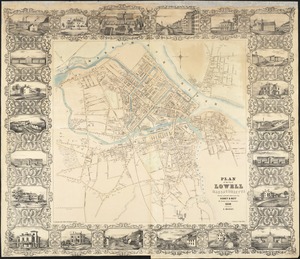URBAN GROWTH IN AN AGE OF INDUSTRIALIZATION, TRANSPORTATION INNOVATIONS, AND EXPANSION
Created by:
Kim Frederick (Concord Academy), 2019 Carolyn A. Lynch Summer Teacher Fellow at the Norman B. Leventhal Map & Education Center
In the Antebellum Period (1820–1860) the United States was growing: in geographical size; in population; in transportation networks; in economic activity; in productivity.
This Map Set will help students explore the ways that industrialization, transportation, and expansion led to the growth of cities across the United States. As the American economy increasingly enmeshed the North, the South, and the West, the United States became increasingly urbanized.
But not all urban growth was the same. In some places, existing cities grew and changed in nature. But in many places, cities were built as urban spaces from their inception on rural farmlands, along railroads or canals, and lands that had recently been taken from Native nations. This Map Set will consider four cities that grew in the Antebellum period: Lowell, Massachusetts; New Orleans, Louisiana; Chicago, Illinois; and San Francisco, California.
Of the four cities, only New Orleans existed as a city before the Antebellum period. Lowell, Chicago, and San Francisco were all built as cities on sites that had little in the way of urban development. All four grew because of the combination of industrialization, immigration, the development of transportation networks, and the American belief in its own self-creation as a nation.
There is a full series of lessons and readings that accompany this map set. To access them or for more information, please email info@leventhalmap.org.
Kim Frederick (Concord Academy), 2019 Carolyn A. Lynch Summer Teacher Fellow at the Norman B. Leventhal Map & Education Center
In the Antebellum Period (1820–1860) the United States was growing: in geographical size; in population; in transportation networks; in economic activity; in productivity.
This Map Set will help students explore the ways that industrialization, transportation, and expansion led to the growth of cities across the United States. As the American economy increasingly enmeshed the North, the South, and the West, the United States became increasingly urbanized.
But not all urban growth was the same. In some places, existing cities grew and changed in nature. But in many places, cities were built as urban spaces from their inception on rural farmlands, along railroads or canals, and lands that had recently been taken from Native nations. This Map Set will consider four cities that grew in the Antebellum period: Lowell, Massachusetts; New Orleans, Louisiana; Chicago, Illinois; and San Francisco, California.
Of the four cities, only New Orleans existed as a city before the Antebellum period. Lowell, Chicago, and San Francisco were all built as cities on sites that had little in the way of urban development. All four grew because of the combination of industrialization, immigration, the development of transportation networks, and the American belief in its own self-creation as a nation.
There is a full series of lessons and readings that accompany this map set. To access them or for more information, please email info@leventhalmap.org.
















































